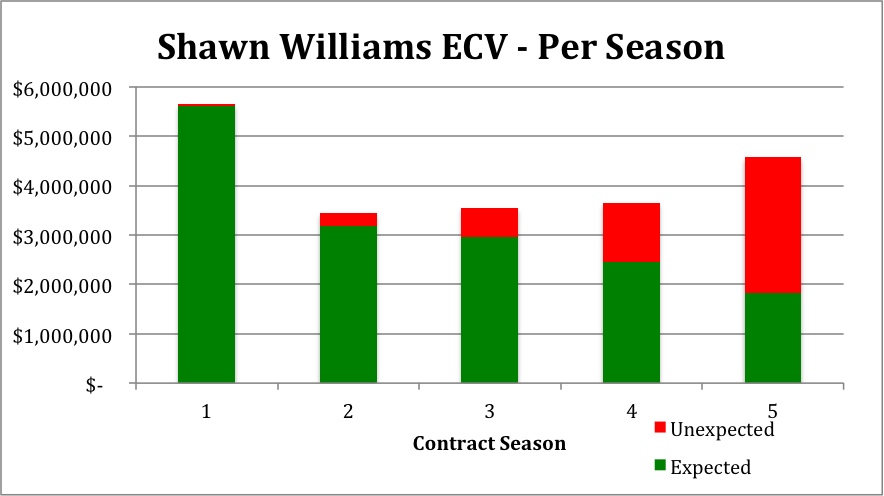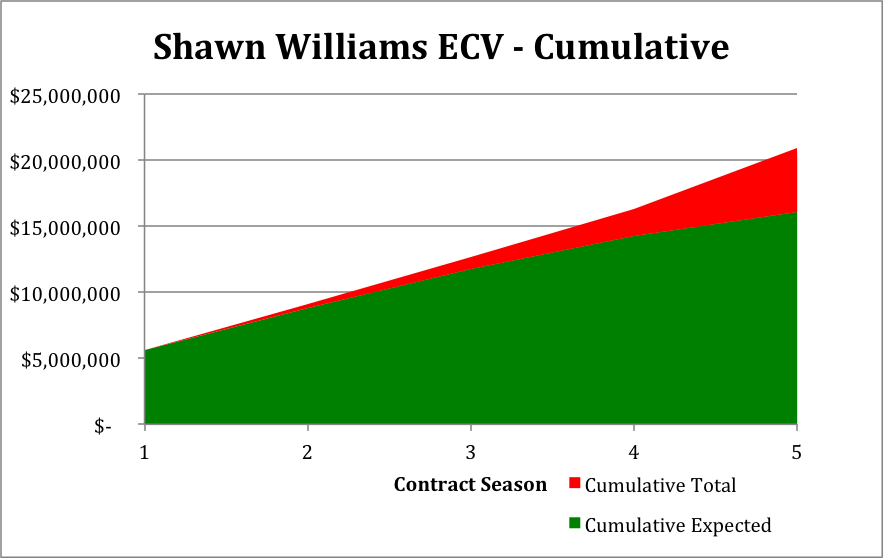Shawn Williams signed a four-year extension with the Bengals reportedly worth a stated value of $20,870,000, of which $20.185 million is considered “new money” and $4 million is guaranteed at the time of signing. The Expected Contract Value of the deal is $16,082,691 (77% of the stated value):
| Shawn Williams |
| Stated Value: $20,870,000 |
| Year | Salary | Expected Outcome | Expected Value | Guaranteed |
| 2016 | $1,650,000 | 97.9% | $1,615,962 | $4,000,000 |
| 2017 | $3,450,000 | 92.5% | $3,190,298 | — |
| 2018 | $3,550,000 | 83.5% | $2,962,846 | — |
| 2019 | $3,650,000 | 67.5% | $2,462,014 | — |
| 2020 | $4,570,000 | 40.5% | $1,815,571 | — |
| Subtotal | — | $12,082,691 | $4,000,000 |
| Expected Contract Value: | $16,082,691 (77%) |
Williams possesses a strong Expected Contract Value relative to the stated value of his contract. Whereas many players with strong ECVs obtain such a projection via contract structures that provide for significant dead money protection, Williams will have very little dead money protection throughout the term of his contract. However, Williams has two factors working in his favor. First, he will be only be 29 years old during the final season of the contract, which means that there is a reasonable probability that he will not suffer a performance decline prior to 2020.
Second, the way in which contracts are typically valued in the market provides Williams some amount of leeway to suffer a performance decline before the Bengals would determine that releasing him and recapturing the associated salary cap space would be the most efficient use of such salary cap space. The AAV of each new contract is typically measured in terms of new money and new seasons. Williams’ previously scheduled 2017 salary was quite low, so most of the money in this extension is new money. The new money amount is divided over only 4 seasons instead of 5 seasons for purposes of determining AAV.
As a result, Williams is considered “a $5.046 million player”, despite the fact that the overall AAV of his contract is $4.174 million. In the final season of the contract, the Bengals would recapture $4.57 million by releasing Williams. His salary cap number of $4.97 million is irrelevant, because the $400K prorated signing bonus amount will count against the team’s salary cap whether he is retained or released. So if the Bengals consider Williams to be a $5.046 million player, then retaining him at a marginal cost of $4.57 million might seem like somewhat of a bargain. But if the Bengals considered Williams to be a $4.174 million player, then retaining him at a marginal cost of $4.57 million might seem like somewhat of an overpay.
For the Bengals, this contract represents a very modest risk in exchange for sizeable upside. If Williams plays well during the 2016 season – and the Bengals are in the best position to make an educated guess as to whether that will happen – it is not difficult to imagine that he would have been in a position to command $6-7 million per season like George Iloka, Tashaun Gipson or Rodney McLeod did this offseason. If so, the Bengals will reap $2-3 million in surplus value each season of the contract.
If Williams doesn’t play particularly well during the 2016 season, as a young player with starting experience, he would probably still be able to command a contract in the $4 million per year range like Isa Abdul Quddus and Andrew Sendejo did this offseason. If so, then the Bengals already have Williams signed to an appropriate contract in 2017 with no guaranteed money remaining as of 2017. Even if Williams completely fails as a starter, then the Bengals can release him and incur only $1.6 million worth of dead money.
The Bengals have risked $6.965 million (the guaranteed money, plus other increase in 2016 compensation) for a chance at reaping $2-3 million worth of surplus value per season over a four-year period (2017-2020), with a fallback outcome of ending up with an appropriately priced contract with little long-term risk and four season’s worth of optionality. This is the type of proactive contract extension practice that, if practiced on a large scale, adds up to a favorable team salary cap situation over a number of years.
The Bengals rank 28th in Commitment Index, which is remarkable considering the number of key players signed to long-term contracts. The team will likely use most of its True Cap Space each year by choosing not to release players already under contract, but the team will have the ability to pivot and make changes if players that are productive now begin to suffer performance declines over the next year or two.
| Shawn Williams |
| Year | Cap Number | Probability | Dead Money | Probability | Expected Cap Number |
| 2016 | $4,188,986 | 97.9% | $4,138,986 | 2.1% | $4,187,936 |
| 2017 | $3,850,000 | 92.5% | $1,600,000 | 7.5% | $3,681,250 |
| 2018 | $3,950,000 | 83.5% | $1,200,000 | 16.5% | $3,496,250 |
| 2019 | $4,050,000 | 67.5% | $800,000 | 32.5% | $2,993,750 |
| 2020 | $4,970,000 | 40.5% | $400,000 | 59.5% | $2,250,850 |
| Total: | | | | $16,610,036 |


Bryce Johnston earned his J.D. from Georgetown University Law Center in May 2014, and currently works as a corporate M&A associate in the New York City office of an AmLaw 50 law firm. Before becoming a contributor to overthecap.com, Bryce operated eaglescap.com for 10 NFL offseasons, appearing multiple times on 610 WIP Sports Radio in Philadelphia as an NFL salary cap expert. Bryce can be contacted via e-mail at bryce.l.johnston@gmail.com or via Twitter @NFLCapAnalytics.
Nick Barton is a junior at the McDonough School Business at Georgetown University. He is majoring in Finance and Operations and Information Management. Nick currently interns with an NFL team . His prior work experience includes interning with CollegeSplits and Dynamic Sports Solutions, and working as a research assistant for the Center of Applied Research of the Apostolate.

